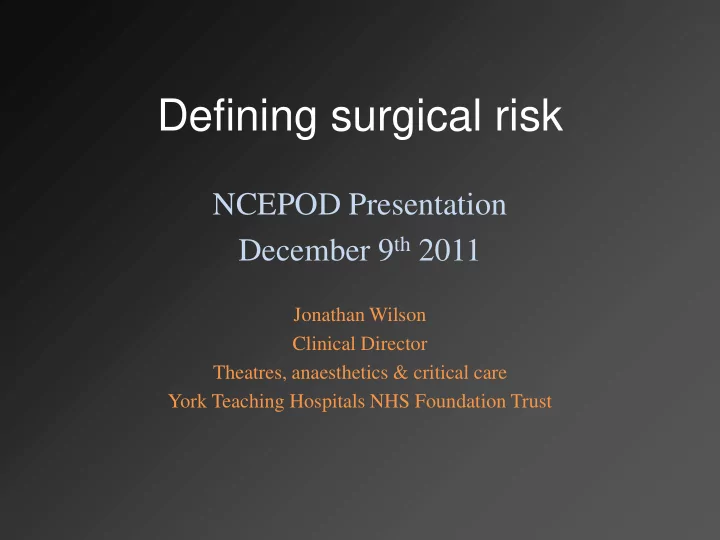

Defining surgical risk NCEPOD Presentation December 9 th 2011 Jonathan Wilson Clinical Director Theatres, anaesthetics & critical care York Teaching Hospitals NHS Foundation Trust
Defining surgical risk • Challenges from the report “Knowing the Risk” • Defining risk and allocating care: clinical judgement or objective measurement? • Understanding the dynamic nature of surgical risk
Challenges from the report • “The first challenge is to reliably and accurately predict the patient group that is at high- risk of mortality and morbidity…… …. the literature is full of differing descriptions, scoring systems and tests to meet this aim. • “the difficulty is that the NHS generally does not seem to be rising to the challenge”
Challenges from the report • Pre-assessment • 16% - no anaesthetic clinic • 17% - no surgical clinic • 20% of high-risk elective patients not seen in pre-assessment clinics (with x7 mortality) • Mortality estimate given in only 7.5% of high- risk cases
Challenges from the report – defining the risk for the individual • High-risk procedures • vascular / abdominal / thoracic / emergency • High-risk patients • co-morbidities / lack of functional capacity Elective open aneurysm repair 12% 1.5% Elective colorectal resection 4.0% 0.5%
Challenges from the report – defining the risk for the individual • Clinical judgement • Definition? • Clinical (objective) measurement • Utility?
Co-morbidities
Co-morbidities
Co-morbidities
Lee’s cardiac risk index • Risk of cardiac events only • No consideration of treatment effect • No estimate of the effect of disease on functional capacity ie ability to perform tasks of daily living
Co-morbidities
Cardio-pulmonary exercise testing • Assessment of functional capacity • Available in ~ 40% of units (NCEPOD 2011) • ~ 10 min cycle test with increasing workload • >90% of elderly surgical patients can do the test
Cardio-pulmonary exercise testing • Anaerobic threshold (AT) – Oxygen consumption at the onset of anaerobic metabolism – The lower the AT, the less fit the patient ! • Ventilatory efficiency (VE/VCO 2 ) – The effort required to get rid of CO 2 – The higher the VE/VCO 2 , the less fit the patient !
Cardio-pulmonary exercise testing – the risks of dying after surgery • Anaerobic threshold (AT) – Less than 11 ml/kg/min : Higher risk – Relative risk of hospital death: 6.8 (1.6-29.5) • Ventilatory efficiency (VE/VCO 2 ) – Greater than 34 : Higher risk – Relative risk of hospital death: 4.6 (1.4-14.8)
CPET-based risk stratification for elective colo-rectal surgery (680 patients) Anaerobic Ventilatory Number of threshold efficiency patients (%) Higher risk Higher risk High risk (VE/VCO 2 223 (33%) (AT<11) >34) Higher risk Lower risk Medium risk 257 (38%) Higher risk Lower risk Lower risk Lower risk Low risk 200 (29%)
CPET-based Elective colo- management Pre-assessment rectal surgery CPET strategy Low risk Medium risk High risk (Either AT OR (AT / VEVCO 2 (AT / VEVCO 2 normal) VEVCO 2 abnormal) abnormal) Arterial line Arterial line Intra-op standard care Intra-op fluid Intra-op fluid optimisation optimisation PACU PACU Extended stay PACU Ward Level 1 ward bed HDU
CPET-based risk stratification for elective colo-rectal surgery (680 patients) Low-risk 0.5 Medium- … 1.5 High-risk 4.1 0 2 4 6 Hospital mortality (%)
Lee’s -based risk stratification and mortality for elective colo-rectal surgery (680 patients) • Lees’s Clinical Risk factors present: 3.0% • Lees’s Clinical Risk factors not present: 1.5%
Lee’s -based risk stratification and mortality for elective colo-rectal surgery (680 patients) • Lees’s Clinical Risk factors present: 3.0% – 211 patients – 6 deaths • Lees’s Clinical Risk factors not present: 1.5% – 469 patients – 7 deaths
Impaired functional capacity is associated with all-cause mortality after major elective intra-abdominal surgery Wilson et al. Br J Anaes 2010 Relative AT < 11 AT > 11 risk Non-survivors Survivors Non-survivors Survivors LCRI 3.3 (0.5- Present 7 177 1 86 20.6) LCRI 10.0 9 264 1 302 Absent (1.7-61.0)
Heart failure or deconditioning? • 30% of patients have parameters of reduced functional capacity on CPET that would put them in a poor prognosis group if they had a heart failure diagnosis • Most of these 30% do not have a diagnosis of heart failure • Whether due to heart failure or deconditioning, reduced functional capacity matters significantly when things go wrong after surgery
The risk of not operating?
Understanding the dynamic nature of surgical risk Case study 3: “This case demonstrates the need for all parts of the patient care pathway to participate in optimisation if risk is to be reduced”
Scoring systems Before surgery CPET Biomarkers Surgical APGAR During surgery score Physiological measuring: Lactate After surgery CV O 2 sats%
The surgical APGAR score • An APGAR score for surgery • Gawande et al • J Am Coll Surg 2007;204:201-208
The surgical APGAR score 3.8% patients had a surgical score ≤ 4 (bad…) 59% had major complications or died within 30 days after surgery 29% patients had a surgical score ≥ 9 (good…) 4% had major complications or died within 30 days after surgery RR 16.1 (7.6-34.0)
Critical need for objective assessment of postsurgical patients Editorial: Gawande. Anesthesiology 2011 • “a major reason the surgical APGAR score is not used is that surgeons and anaesthesiologists(sic) believe that their subjective impressions of patient condition are accurate …”
Conclusion • “There is a need to introduce a UK wide system that allows rapid and easy identification of patients who are at high-risk of postoperative mortality and morbidity” • Departments of Health in England, Wales and Northern Ireland
Conclusion • Dynamic, responsive to evolving situation • Based on evidence, not just on expert opinion • Where evidence does not exist, supply funding (from NIHR direct) to gather it through research and audit (grassroots not Ivory Tower) • Give absolute clarity to what should be considered mandatory
?
Recommend
More recommend